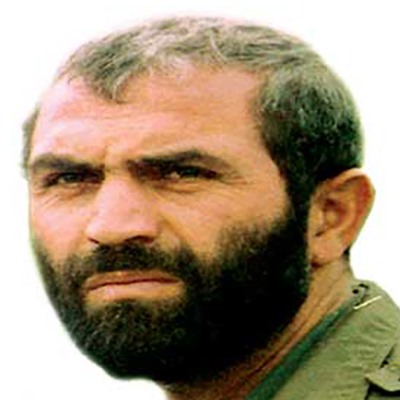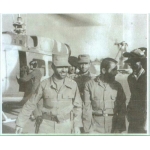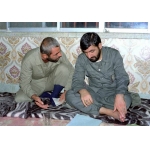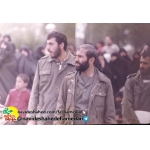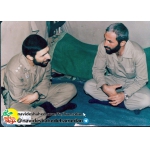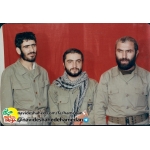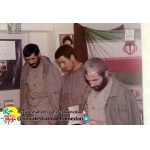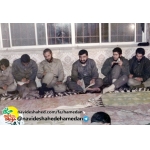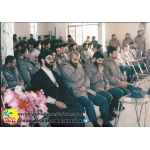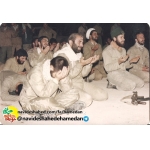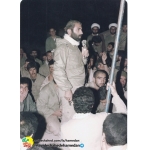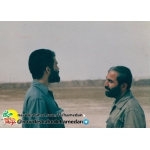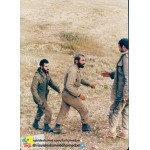People
Hamedani, Hussain
Seyyed Ahmad Hussaini
255 Views
Brigadier General Hussain Hamedani[1] was a military commander during the Iran-Iraq War who was martyred in Syria in 2015.
Hussain Hamedani, the third child in his family, was born on December 15, 1950.[2] From a young age, he used to both work and study. He was a wrestler[3] and admired Gholamreza Takhti. In 1971, he was drafted into military service.[4] At the age of 27, he married his cousin, Parvaneh Cheragh Norouzi. They had two daughters and two sons.[5]
On the eve of February 8, 1979, Hamedani and other fighters from Hamedan managed to stop a military column of the 81st Armored Brigade heading to Tehran for a coup.[6] In 1979, he joined the Hamedan branch of the Islamic Revolutionary Guard Corps (IRGC)[7] and became a military training instructor at the Abu Zar Barracks located southeast of Sarpol-e Zahab.[8]
In mid-1979, he was deployed with six groups to Mahabad to counter separatists in the Kurdish regions.[9] During the liberation of the strategic Salavatabad Pass on the Qorveh-Sanandaj axis, which was crucial for reclaiming Sanandaj, he met Ali Sayyad Shirazi.[10] As Colonel Sayyad Shirazi, the commander of the Western Operational Headquarters of the Army, requested, Hamedani went to the border areas of Qasr-e Shirin to Dasht-e Zahab in late June 1980.[11]
In a significant meeting with President Abolhassan Banisadr and senior commanders held in Kermanshah on August 15, 1980, Hamedani presented a detailed report on Iraqi military activities in Sarpol-e Zahab and Tilleh-Kuh.[12]
When the Iran-Iraq War broke out, Hamedani was in Hamedan preparing forces for deployment to the border regions.[13] With six IRGC members, he immediately went to Sarpol-e Zahab.[14] As one of the regional commanders, he played a significant role in halting the enemy’s advance and preventing the fall of Sarpol-e Zahab[15] through innovative strategies and decisive action.[16]
In 1981, Mahmoud Shahbazi Dastjerdi, the commander of the Hamedan IRGC, appointed Hamedani as the logistics officer for the Hamedan IRGC.[17] After organizing logistics, Hamedani returned to the Sarpol-e Zahab[18] front in early July 1981 while retaining his position. He, along with three other commanders, began carrying out reconnaissance missions in four areas to prepare the forces for launching the Operation Shahid Rajai and Bahonar which the Supreme Defense Council[19] had approved.[20]
On September 2, 1981[21], Shahbazi tasked Hamedani with commanding Hamedan IRGC forces stationed in the Koremoush, Qaraviz, and Bazi Deraz[22] heights. [23] Also, on December 19, 1981[24], he led the second phase of Operation Matla al-Fajr in the Tang-e Kork which had begun[25] on December 11.[26]
With Shahbazi’s coordination[27], Hamedani, along with elite Hamedan IRGC personnel, went to southern Iran to help establish the newly formed 27th Muhammad Rasulullah (pbuh) Division.[28] He became responsible for the Beleta[29] (Dasht-e Abbas) front[30], accompanying teams in reconnaissance missions.[31]
During Operation Fath al-Mobin, which began on March 22, 1982,[32] he was appointed deputy commander of the division.[33] He later assisted Shahbazi in managing the division’s right flank, including the Tineh Heights and Abuqoraib Straight.[34] During the fourth phase of the operation, Hamedani led the forces in the Tineh[35] area.[36]
During the liberation of Khorramshahr, Hamedani actively participated in reconnaissance of enemy positions in western Karun and Dasht-e Taheri.[37] Also, during Operation Beit al-Muqaddas, which began on April 30, 1982,[38] he served as deputy of Shahbazi commanding the Salman axis.[39] On May 7, he was injured in the knee[40] but returned to the battlefield less than two weeks[41] later to participate in the operation.[42]
Hamedani also took part in operations Ramadan[43] launched on July 13, 1982,[44] and later in Moslim ibn Aqil carried out on October 1, 1982,[45] during which he helped the commander of the 27th Muhammad Rasulullah (pbuh) Division, Muhammad Ebrahim Hemmat.[46]
In the same year, with the formation of the newly formed Ansar al-Hussain Brigade in Hamedan, Hussain Hamedani was appointed as its commander.[47] He participated in Operation Valfajr 2,[48] which began on July 20, 1983,[49] in Haj Omran Heights.[50] From the second day of the operation, the forces from Hamedan managed to capture key strategic heights, including the 3,000-meter-high Kado, heights 2062 and 2019, and their connecting ridges. Therefore, the 10th Seyyed al-Shuhada (as) Brigade and the 14th Imam Hussain (as) and 8th Najaf Ashraf Divisions (IRGC) took control of that area, preventing the enemy from regaining liberated areas. [51] During this operation, Hamedani sustained shrapnel injuries to his back.[52]
He also participated in Operation Valfajr 5 (February 15, 1984) launched in Changuleh. As a result, all targeted heights were captured, disrupting enemy transportation from the west to the south.[53] Moreover, during Operation Ashura (September 16, 1984),[54] he commanded the troops from Hamedan in Meimak.[55]
In the summer of 1986, Hamedani was appointed commander of the newly formed 16th Quds Division in Gilan.[56] With five battalions under his command, he participated in Operation Karbala 2 which was carried out in the Haj Omran on September 1, 1986.[57] Later, the Quds Division, under his leadership,[58] joined Operation Karbala 5 on January 9, 1987,[59] with nine battalions. On January 16, 1987, while directing forces, he was injured in the leg.[60] On February 22, 1987,[61] when Operation Karbala 5 was launched in the Nahr-e Jassim area, he led three battalions into the battle.[62]
From June 1987, Hamedani assumed responsibility for the staff of the Third Corps and the deputy operational commander of the Western Command Headquarters. He conducted reconnaissance missions deep into Iraqi Kurdistan.[63] He played a decisive role in countering Iraq’s invasion of southern Iran during the later stages of the war [64] and in Operation Mersad on July 25, 1988.[65] He remained in that position until the end of the war [66] in 1988 when he commanded the Hamedan IRGC and the 32nd Ansar al-Hussain (as) Division.[67]
After the war, Hamedani completed the Command and General Staff Course (DAFOOS) at the Army Command and Staff University.[68] He also directed cross-border operations against the Mojahedin-e Khalq Organization (Munafiqeen) in Iraqi Kurdistan.[69]
In 1991, Hamedani took command of the Najaf Headquarters and the 4th Besat Division.[70] In 1995 and 1999, he became the coordinating deputy of the IRGC Ground Forces[71] and the deputy commander of the Basij Resistance Force respectively.[72] In 2001, he was deployed as a military advisor to Congo.[73] From 2002, Hamedani commanded the 27th Muhammad Rasulullah (pbuh) Division. In 2006, he became the deputy commander of the Tharallah Headquarters in Tehran and a senior advisor to the IRGC Commander-in-Chief.[74]
He also established the Adl-e Eslami Fund[75] and the Hamedan Martyrs Congress. From late 2009, as the commander of the Greater Tehran Muhammad Rasulullah (pbuh) Corps, he played a key role in maintaining security in the capital.[76]
In 2011, Hamedani served as a senior IRGC advisor, playing a significant role in securing and preserving Syria’s legitimate government.[77] He mobilized local forces to defend Syria against ISIS terrorists.[78] His last position was commander of the Imam Hussain (as) Strategic Headquarters, starting in 2014.[79]
Hamedani returned to Syria and, during advisory missions, was martyred on October 8, 2015, near Aleppo.[80] His body was honored in Damascus,[81] Tehran, and Hamedan and buried in the Martyrs’ Cemetery of Bagh-e Behesht, Hamedan.[82] Before martyrdom, he was a Brigadier General and later promoted to Major General. He was twice awarded the First Fath Medal[83] for his leadership and command during the Iran-Iraq War.
Eight works documenting his memories have been published, including Taklif Ast Baradar (It’s a Duty, Brother), Fatehan-e Khorramshahr (The Conquerors of Khorramshahr), Mahtab-e Khin (Moonlight of Khin), Peygham-e Mahiha (Message of the Fish), Abu Wahab, Habib-e Haram (The Beloved of the Shrine), Saat Shanzdah be Vaght-e Halab (4 PM Aleppo Time), and Khodahafez Salar (Goodbye, Commander).[84]
[1] Behzad, Hussein, Mahtab Khin: Ravaayat-e Farmandeh Basiji Hussein Hamadani az Enqelab, Kurdistan va Defa Moqaddas (Mahteab Khin: The Narrative of Martyr Hussain Hamadani's Command in the Revolution, Kurdistan, and Sacred Defense), Tehran: Fathian, 3rd edition, 1389, Pp. 109 and 929.
[2] Behzad, Hussain, Ibid., p. 19.
[3] Ibid., Pp. 20 and 21.
[4] Ibid., p. 26.
[5] Ibid., p. 27.
[6] Ibid., p. 32.
[7] Behzad, Hussain, Babayi, Gol-Ali, Az Alvand ta Qaravez (From Alvand to Qaravez), Tehran: Bonyad Hefz Asar-e Defa Muqaddas, 1378, p. 496.
[8] Behzad, Hussain, Ibid., p. 37; Pourjabbari, Pejman, Atlas-e Joghrafiya-ye Hamaasi 3: Kermanshah dar Jang (Atlas of Epic Geography 3: Kermanshah in War), Tehran: Sarir, 1392, p. 107.
[9] Behzad, Hussain, Ibid., p. 50.
[10] Behzad, Hussain, Babayi, Gol-Ali, Az Alvand ta Qaravez (From Alvand to Qaravez), p. 355; Behzad, Hussain, Ibid., Pp. 54-56.
[11] Behzad, Hussain, Ibid., Pp. 64 and 65; Behzad, Hussain, Babayi, Gol-Ali, Az Alvand ta Qaravez (From Alvand to Qaravez), Pp. 490, 501, 502.
[12] Ibid., Pp. 71-72; Ibid., Pp. 509-510.
[13] Behzad, Hussain, Ibid., p. 74.
[14] Behzad, Hussain, Babayi, Gol-Ali, Az Alvand ta Qaravez (From Alvand to Qaravez), Pp. 573, 584.
[15] Behzad, Hussain, Ibid., Pp. 97-82.
[16] Behzad, Hussain, Ibid., Pp. 97 and 115; Behzad, Hussain, Babayi, Gol-Ali, Az Alvand ta Qaravez (From Alvand to Qaravez), p. 651.
[17] Behzad, Hussain, Ibid., p. 142.
[18] Ibid., p. 174.
[19] Ibid., p. 178.
[20] Ibid., Pp. 180-181.
[21] Rashid, Mohsen, Dari, Hassan, Kaarnameh-ye Nabardha-ye Zamini (The Ground Battles Report), Tehran: Sepah Pasdaran-e Enqelab-e Islami, Markaz-e Mutaleat va Tahqiqat-e Jang, 1381, p. 112.
[22] Rashid, Mohsen, Atlas-e Jang-e Iran va Iraq (Atlas of the Iran-Iraq War), Tehran: Markaz-e Asnad va Tahqiqat-e Defa Moqaddas Sepah Pasdaran-e Enqelab-e Eslami, 3rd edition, 1392, p. 37.
[23] Behzad, Hussain, Ibid., p. 202.
[24] Shir-Ali-Nia, Jafar, Dayereh-al-Maarif-e Masour-e Tarikh-e Jang-e Iran va Iraq (Illustrated Encyclopedia of the History of the Iran-Iraq War), Tehran: Sayan, 4th edition, 1394, p. 176.
[25] Rashid, Mohsen, Dari, Hassan, Ibid., p. 113.
[26] Behzad, Hussain, Ibid., p. 252.
[27] Ibid., Pp. 328-335.
[28] Ibid., Pp. 336-354.
[29] Ibid., p. 402.
[30] Ibid., p. 402.
[31] Ibid., Pp. 425-484.
[32] Rashid, Mohsen, Dari, Hassan, Ibid., p. 80.
[33] Behzad, Hussain, Ibid., p. 428.
[34] Ibid., p. 573.
[35] Ibid., p. 593.
[36] Ibid., p. 594.
[37] Ibid., Pp. 681-726; Behzad, Hussain, Babaei, Gol-Ali, Hampay-e Saeqe (Alongside the Thunder), Tehran: Sura Mehr, 20th edition, 1392, p. 402.
[38] Rashid, Mohsen, Dari, Hassan, Ibid., p. 81; Elaei, Hussain, Tarikh-e Tahlili-ye Jang-e Iran va Iraq (Analytical History of Iran-Iraq War), Vol. 1, Tehran: Marz-o-Boom, 1395, p. 461.
[39] Behzad, Hussain, Ibid., Pp. 740-765; Behzad, Hussain, Babaei, Gol-Ali, Hampay-e Saeqe (Alongside the Thunder), p. 600.
[40] Ibid., Pp. 893-900; Ibid., p. 643.
[41] Hesam, Hamid, Khodahafez Salaar (Goodbye Commander), Tehran: 27, 1396, p. 192.
[42] Behzad, Hussain, Ibid., p. 917.
[43] Rashid, Mohsen, Dari, Hassan, Ibid., p. 90
[44] Tehran: Bonyad-e Hafez Asar va Nashr-e Arzesh-haye Defa Moqaddas, 1393, p. 276; Hesam, Hamid, Ibid., p. 196.
[45] Rashid, Mohsen, Dari, Hassan, Ibid., p. 120; Elaei, Hussain, Ibid., Vol. 1, p. 571.
[46] Hesam, Hamid, Ibid., p. 198.
[47] Ibid., p. 198; Hamadani, Zahra, Shokri, Hassan, Saat Shanzdah Be Vaqt-e Halab (Sixteen O'clock in Aleppo Time), Tehran: Saeqe, 1395, p. 14.
[48] Shalbafian, Amir, Ibid., p. 280.
[49] Rashid, Mohsen, Dari, Hassan, Ibid., p. 135.
[50] Elaei, Hussain, Ibid., Vol. 1, Pp. 617-618.
[51] Shalbafian, Amir, Ibid., p. 280.
[52] Hesam, Hamid, Ibid., p. 202.
[53] Elaei, Hussain, Ibid., Vol. 2, p. 50; Shalbafian, Amir, Ibid., p. 282; Hamadani, Zahra, Shokri, Hassan, Ibid., p. 14.
[54] Rashid, Mohsen, Dari, Hassan, Ibid., p. 122; Elaei, Hussain, Ibid., Vol. 2, p. 90; Shalbafian, Amir, Ibid., p. 286.
[55] Shalbafian, Amir, Ibid., p. 14.
[56] Gholami, Ali-Reza, Shour-e Asheqi (The Passion of Love), Tehran: Mouzei-e Enqelab Eslami va Defa Moqaddas, 1398, p. 144.
[57] Rashid, Mohsen, Dari, Hassan, Ibid., p. 139; Saleh-Fakhari, Reza, Roozhaye Khob-e Khoda (The Good Days of God), Vols. 1 and 2, Rasht: Kadiour, 1393, p. 16.
[58] Saleh-Fakhari, Reza, Ibid., p. 216.
[59] Rashid, Mohsen, Dari, Hassan, Ibid., p. 98.
[60] Saleh-Fakhari, Reza, Ibid., p. 194; Hesam, Hamid, Ibid., Pp. 245-246.
[61] Rashid, Mohsen, Dari, Hassan, Ibid., p. 99.
[62] Saleh-Fakhari, Reza, Ibid., p. 211.
[63] Hesam, Hamid, Ibid., Pp. 252-253.
[64] Rashid, Mohsen, Dari, Hassan, Ibid., Pp. 161-164.
[65] Ibid., p. 166; Hesam, Hamid, Ibid., p. 253.
[66] Hamadani, Zahra, Shokri, Hassan, Ibid., p. 14.
[67] Hesam, Hamid, Ibid., p. 64.
[68] Shahid Yaran, Sh. 125-126, Esfand 1394 va Farvardin 1395, p. 77.
[69] Ibid., p. 273.
[70] Ibid., p. 276.
[71] Ibid., p. 280.
[72] Hamadani, Zahra, Shokri, Hassan, Ibid., p. 15.
[73] Hesam, Hamid, Ibid., p. 290.
[74] Hamadani, Zahra, Shokri, Hassan, Ibid., p. 15.
[75] Hesam, Hamid, Ibid., Pp. 306-307; Ruznameh Kayhan (Keyhan Newspaper), Sh. 22031, 29 Mehr 1397, p. 8.
[76] Hamadani, Zahra, Shokri, Hassan, Ibid., p. 15.
[77] Ruznameh Etemad (Etemad Newspaper), Sh. 4641, 18 Ordibehesht 1399, p. 6.
[78] Hamadani, Zahra, Shokri, Hassan, Ibid., p. 15; Ruznameh Kayhan (Keyhan Newspaper), Sh. 21178, 18 Mehr 1394, p. 3.
[79] Ibid., p. 15.
[80] Ruznameh Kayhan (Keyhan Newspaper), Sh. 21178, 18 Mehr 1394, p. 3.
[81] Ruznameh Kayhan (Keyhan Newspaper), Sh. 21180, 20 Mehr 1394, p. 3.
[82] Ruznameh Kayhan (Keyhan Newspaper), Sh. 21180 va 21181, 20 va 21 Mehr 1394, p. 3.
[83] Ibid., Sh. 21178, 18 Mehr 1394, p. 3.
[84] Hazad, Hussain, Taklif Ast Baradar (It is A Duty Brother), Tehran: Ghoncheh: Farhangsaraye Paydari, 1383; Nasrollah Zanjani, Hussain, Fatehan Khorramshahr 32: Mozd-e Moqavemat (The Conquerors of Khorramshahr 32: The Reward of Resistance), Ravayat-e Sardar Hussain Hamadani, Tehran: Sarir, 1387; Behzad, Hussain, Mahtab-e Khein (Moonlight of Khein), Ravayat-e Farmandeh Basiji Hussain Hamadani az Enqelab, Kordestan va Defa Moqaddas, Tehran: Fatehan, 3rd Edition, 1389; Babaei, Gol-Ali, Paygham-e Mahiha (The Message of the Fishes), Tehran: 27 Besat, 1395; Hamadani, Sara, Shokri, Seyed Hassan, Abuvahab (Abu Wahb), Tehran: 27 Besat, 1398; Moradpour, Amirreza, Habib-e Haram (The Beloved of the Shrine), Ardabil: Khat-e Hasht, 1396; Hamadani, Zahra, and Shokri, Seyyed Hassan, Saat-e Shanzdah Be Vaght-e Halab (4 PM in Aleppo), Tehran: Saeqe, 1395; Hesam, Hamid, Khodahafez Salar (Goodbye Commander), Tehran: 27 Besat, 1396.




